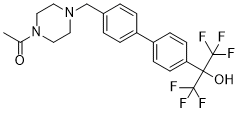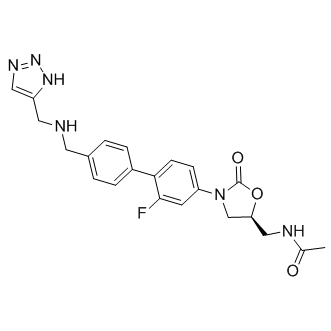 To enhance service speed and avoid tariff delays, we've opened a US warehouse. All US orders ship directly from our US facility.
To enhance service speed and avoid tariff delays, we've opened a US warehouse. All US orders ship directly from our US facility.
| Cat. No. | Product Name | Field of Application | Chemical Structure |
|---|---|---|---|
| DC7944 | LY2090314 Featured |
LY2090314 is a potent inhibitor of glycogen synthase kinase-3 (GSK-3) with IC50s of 1.5 nM and 0.9 nM for GSK-3α and GSK-3β respectively.
More description
|

|
| DC23724 | SR1555 Featured |
SR1555 is a selective RORγ inverse agonist (IC50=1.5 uM) that suppresses T(H)17 cells and stimulates T regulatory cells.
More description
|

|
| DC23732 | KT-5823 Featured |
KT-5823 is a potent, highly specific PKG (cGMP-dependent protein kinase) inhibitor with Ki of 0.234 uM, displays little to no activity for MLCK, cAPK, and PKC.
More description
|

|
| DC23736 | Z62954982 Featured |
Z62954982 is a potent, specific Rac1 inhibitor, reduces the intracellular levels of Rac1-GTP in a concentration-dependent manner with IC50 of 12 uM, 4 times more effective than NSC23766 (IC50=50 uM).
More description
|

|
| DC23781 | YM-1 Featured |
YM-1 is a close derivative of MTK-077 that allosterically promotes Hsp70 binding to unfolded substrates, specificly binds to Hsp70 with Kd of 4.9 uM.
More description
|

|
| DC23834 | Rottlerin Featured |
Rottlerin (Mallotoxin.
More description
|

|
| DC23864 | AAL993 Featured |
AAL993 (ZK260253) is a potent, orally active VEGFR inhibitor with IC50 of 130, 23 and 18 nM for VEGFR-1, 2 and 3, respectively.
More description
|

|
| DC23934 | FTI-277 Featured |
A peptide mimetic of the C-terminal Cys-Val-Ile-Met of K-Ras4B that potently inhibits FTase (Farnesyltransferase) with IC50 of 0.5 nM.
More description
|

|
| DC23962 | Cilobradine Featured |
A hyperpolarization-activated cyclic nucleotide-gated (HCN) channel.
More description
|

|
| DC24118 | C75 Featured |
C75 is an inhibitor synthetic fatty-acid synthase (FASN) and inhibits prostate cancer cells PC3 (IC50: 35 μM).
More description
|

|
| DC25079 | Biperiden hydrochloride Featured |
Biperiden Hcl (NSC 170950, NSC 84989) is a centrally-acting antiparkinsonian agent that functions as a selective central M1 cholinoreceptors blocker..
More description
|

|
| DC28084 | Hydroxybupropion Featured |
Hydroxybupropion is the major active metabolite of Bupropion. Hydroxybupropion is metabolized by CYP2B6.Bupropion is an atypical antidepressant and smoking-cessation agent. Hydroxybupropion inhibits norepinephrine uptake with an IC50 value of 1.7 μM. Hydroxybupropion is also a nACh receptor antagonis tis more potent than Bupropion .
More description
|

|
| DC28109 | Dilazep dihydrochloride Featured |
Dilazep dihydrochloride is an inhibitor of adenosine uptake. Dilazep dihydrochloride has cerebral and coronary vasodilating action through enhancement of effect of adenosine. Dilazep dihydrochloride also inhibits the ischemic damage, platelet aggregation, and membrane transport of nucleosides.
More description
|

|
| DC58110 | Dclk1-IN-1 Featured |
DCLK1-IN-1 is a selective, oral bioavailability in vivo-compatible chemical probe of the doublecortin like kinase 1 (DCLK1 kinase) domain. DCLK1-IN-1 inhibits DCLK1 and DCLK2 kinases (IC50: DCLK1=9.5/57.2 nM and DCLK2=31/103 nM in binding and kinase assay, respectively). DCLK1-IN-1 shows low toxicity, and can investigate DCLK1 biology and establish its role in cancer, like DCLK1+ pancreatic ductal adenocarcinoma (PDAC)[1].
More description
|

|
| DC12478 | NSC 260594 Featured |
NSC260594 (NSC 260594) is a specific inhibitor of HIV-1 RNA packaging, which involves preventing the interaction of Gag with SL3 by stabilizing this small RNA stem-loop which then leads to stabilization of the global packaging signal region (psi or ψ).
More description
|

|
| DC28113 | Imetit dihydrobromide Featured |
Imetit dihydrobromide (VUF 8325 dihydrobromide) is a high affinity and potent agonist of histamine H3 and H4 receptors, with Ki values of 0.3 and 2.7 nM, respectively. Imetit mimics histamine effect in triggering a shape change in eosinophils (EC50=25 nM).
More description
|

|
| DC28147 | GR 113808 Featured |
GR 113808 is a potent and highly selective 5-HT4 receptor antagonist (pKb= 8.8). GR 113808 shows 300-fold selectivity over 5-HT1A, 5-HT1B, 5-HT2A, 5-HT2C and 5-HT3 receptors.
More description
|

|
| DC28164 | Ro15-4513 Featured |
Ro15-4513, imidazobenzodiazepinone derivative, is a partial inverse agonist of benzodiazepine receptor (BZR). Ro15-4513 is a potent ethanol antagonist. Ro15-4513 has anti-anxiety effect.
More description
|

|
| DC28187 | Asoxime dichloride Featured |
Asoxime dichloride (HI-6) is an antagonist to acetylcholine receptors (AChRs) including the nicotinic receptor, α7 nAChR. Asoxime dichloride involves in modulating immunity response. Asoxime dichloride (HI-6) can be used as an antigen and improves vaccination efficacy in the nervous system.
More description
|

|
| DC28212 | Picrotin Featured |
Picrotin is an inhibitor of glycine receptors (GlyRs) which blocks α2 GlyR, α1 GlyR and α3 GlyR.
More description
|

|
| DCAPI1271 | Ubenimex (Bestatin) Featured |
Bestatin is a natural, broad-spectrum, and competitive aminopeptidase inhibitor.
More description
|

|
| DC9351 | Radezolid Featured |
Radezolid (RX-1741) is a novel oxazolidinone antibiotic agent.
More description
|

|
| DC26095 | QX 314 chloride Featured |
A membrane-impermeable sodium channel blocker, blocks sodium current in voltage-clamped nociceptive DRG neurons.
More description
|

|
| DC28240 | Alexidine dihydrochloride Featured |
Alexidine dihydrochloride is an anticancer agent that targets a mitochondrial tyrosine phosphatase, PTPMT1, in mammalian cells and causes mitochondrial apoptosis. Alexidine dihydrochloride has antifungal and antibiofilm activity against a diverse range of fungal pathogens.
More description
|

|
| DC28242 | 15-Deoxy-Δ-12,14-prostaglandin J2 Featured |
15-Deoxy-Δ-12,14-prostaglandin J2 (15d-PGJ2) is a cyclopentenone prostaglandin and a metabolite of PGD2. 15-Deoxy-Δ-12,14-prostaglandin J2 is a selective PPARγ (EC50 of 2 µM) and a covalent PPARδ agonist. 15-Deoxy-Δ-12,14-prostaglandin J2 promotes efficient differentiation of C3H10T1/2 fibroblasts to adipocytes with an EC50 of 7 μM.
More description
|

|
| DC28241 | L-161982 Featured |
L-161982 is a selective EP4 receptor antagonist. L-161982 completely blocks PGE2-induced ERK phosphorylation and cell proliferation of HCA-7 cells. L-161982 alleviates collagen-induced arthritis in mice.
More description
|

|
| DC28267 | (Rac)-LM11A-31 dihydrochloride Featured |
(Rac)-LM11A-31 dihydrochloride is an isomer of LM11A-31 dihydrochloride. LM11A-31 dihydrochloride, a p75NTR (neurotrophin receptor p75) Ligand, is a potent proNGF (nerve growth factor) antagonist.
More description
|

|
| DC28298 | cis-Urocanic acid Featured |
cis-Urocanic acid is a 5-HT2A receptor agonist. cis-Urocanic acid binds to 5-HT receptor with relatively high affinity (Kd=4.6 nM). cis-Urocanic acid is an immune modulator that induces immunosuppression by binding to the 5-HT2A receptor.
More description
|

|
| DC28320 | 7α,25-Dihydroxycholesterol Featured |
7α, 25-dihydroxycholesterol (7α,25-OHC) is a potent and selective agonist and endogenous ligand of the orphan GPCR receptor EBI2 (GPR183). 7α, 25-dihydroxycholesterol is highly potent at activating EBI2 (EC50=140 pM; Kd=450 pM). 7α, 25-dihydroxycholesterol can serve as a chemokine directing migration of B cells, T cells and dendritic cells.
More description
|

|
| DC28317 | Actinonin Featured |
Actinonin ((-)-Actinonin) is a naturally occurring antibacterial agent produced by Actinomyces. Actinonin inhibits aminopeptidase M, aminopeptidase N and leucine aminopeptidase. Actinonin is a potent reversible peptide deformylase (PDF) inhibitor with a Ki of 0.28 nM. Actinonin also inhibits MMP-1, MMP-3, MMP-8, MMP-9, and hmeprin α with Ki values of 300 nM, 1,700 nM, 190 nM, 330 nM, and 20 nM, respectively. Actinonin is an apoptosis inducer. Actinonin has antiproliferative and antitumor activities.
More description
|

|